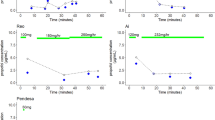Summary
Thirty one anaesthetists were supplied with a pharmacokinetic based target controlled propofol infusion system for evaluation. Twenty seven of 30 replies to a questionnaire sent to them indicated that the system had changed their use of propofol for maintenance of anaesthesia. The main reasons were greater ease of use and more confidence regarding the predictability of anaesthetic effects compared with manually controlled infusion. Data obtained from 770 patients anaesthetised with the system were analysed. The median maximum target concentration selected was 6.6 μg/ml. Younger patients (18–35 yr) required significantly greater target concentrations than older patients (65–80 yr). The mean time during which the system was in maintenance mode, when the predicted blood concentration of propofol was held constant for at least one minute, was 26.1 minutes. The median number of alterations in propofol concentration was 6. The target controlled infusion system provided an inexpensive and acceptable method of delivering intravenous anaesthesia.
Similar content being viewed by others
References
de Grood PMRM, Ruys AHC, van Egmond J, Booij LHDJ, Crul JF. Propofol (‘Diprivan’) emulsion for total intravenous anaesthesia. Postgrad Med J 1985; 61 (3 Suppl): 65S-69S.
Turtle MJ, Cullen P, Prys-Roberts C, Coates DP, Monk CR, Faroqui MH. Dose requirements of propofol by infusion during nitrous oxide anaesthesia in man. Br J Anaesth 1987; 59:283–7.
Roberts FL, Dixon J, Lewis GTR, Tackley RM, Prys-Roberts C. Induction and maintenance of propofol anaesthesia: A manual infusion scheme. Anaesthesia 1988; 43 (Suppl): 14S-17S.
Glass PSA, Markham K, Ginsberg B, Hawkins ED. Propofol concentrations required for surgery. Anesthesiology 1989; 71 (Suppl): A273.
White M, Kenny GNC. Intravenous propofol anaesthesia using a computerised infusion system. Anaesthesia 1990; 45: 204–9.
Marsh B, White M, Morton, Kenny GNC. Pharmacokinetic model driven infusion of propofol in children. Br J Anaesth 1991; 67: 41–8.
Kenny GNC, White M. A portable target controlled propofol infusion system. Int J Clin Monit Comput 1992; 9: 179–82.
Carpenter RL, Eger EI II. Alveolar to arterial to venous anesthetic partial pressure differences in humans. Anesthesiology 1989; 70: 630–5.
Crofts SL, Hutchison GL. General anaesthesia and undrained pneumothorax. The use of a computer-controlled propofol infusion. Anaesthesia 1991; 46: 192–4.
Donnelly JA, Webster RE. Computer-controlled anaesthesia in the management of bronchopleural fistula. Anaesthesia 1991; 46: 383–4.
Chaudhri S, White M, Kenney GNC. Induction of anaesthesia with propofol using a target-controlled infusion system. Anaesthesia 1992; 47: 551–3.
Kirkpatrick T, Cockshott ID, Douglas EJ, Nimmo WS. Pharmacokinetics of propofol (Diprivan) in elderly patients. Br J Anaesth 1988; 60: 146–50.
Author information
Authors and Affiliations
Rights and permissions
About this article
Cite this article
Taylor, I., White, M. & Kenny, G.N.C. Assessment of the value and pattern of use of a target controlled propofol infusion system. J Clin Monitor Comput 10, 175–180 (1993). https://doi.org/10.1007/BF01246452
Accepted:
Issue Date:
DOI: https://doi.org/10.1007/BF01246452




